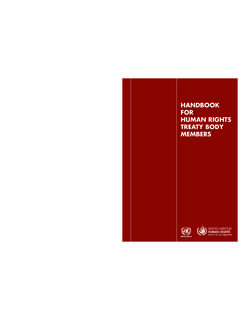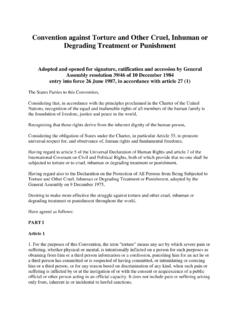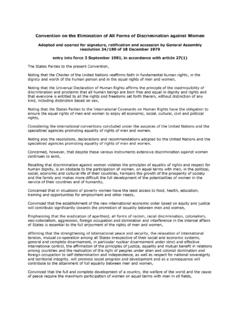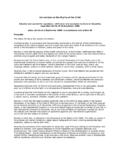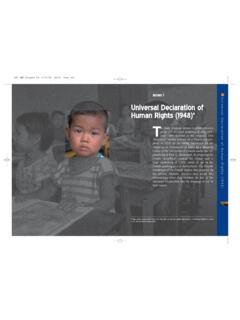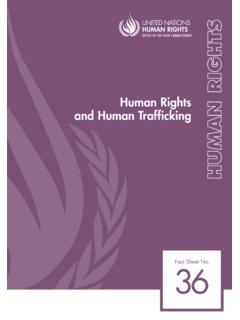Transcription of GOOD NATIONS O H C U GOVERNANCE H R PRACTICES FOR …
1 good . OFFICE OF THE UNITED. NATIONS HIGH COMMISSIONER. FOR HUMAN RIGHTS. GOVERNANCE . PRACTICES FOR. THE PROTECTION. OF HUMAN RIGHTS. UNITED NATIONS . OFFICE OF THE UNITED NATIONS HIGH COMMISSIONER FOR HUMAN RIGHTS. good GOVERNANCE PRACTICES FOR. THE PROTECTION OF HUMAN RIGHTS. UNITED NATIONS . New-York and Geneva, 2007. Note The designations employed and the presentation of the material in this publi- cation do not imply the expression of any opinion whatsoever on the part of the Secretariat of the United NATIONS concerning the legal status of any country, territory, city or area, or of its authorities, or concerning the delimitation of its frontiers or boundaries. *. **. Symbols of United NATIONS documents are composed of capital letters combined with figures. Mention of such a figure indicates a reference to a United NATIONS document. *. **. Material contained in this publication may be freely quoted or reprinted, provid- ed credit is given and a copy of the publication containing the reprinted material is sent to the Office of the United NATIONS High Commissioner for Human Rights, Palais des NATIONS , avenue de la Paix 8-14, CH 1211 Geneva 10, Switzerland.
2 HR/PUB/07/4. UNITED NATIONS PUBLICATION. Sales No. ISBN 978-92-1-154179-3. Photo credits International Labour Organization/J. Maillard (left). UNICEF/HQ06-1473/Giacomo Pirozzi (centre). II. CONTENTS. Page Introduction 1. I. STRENGTHENING DEMOCRATIC INSTITUTIONS 9. A. Institutionalizing public participation in local development South Africa 10. B. Strengthening women's political representation through networking and lobbying Palestine 12. C. The role of the media in building the capacity of rights-holders to participate in local decision-making Philippines 15. D. Strengthening human rights and managing conflict through a participatory, inclusive and transparent constitution-making process . Albania 17. E. A GOVERNANCE system responsive to the needs of the HIV/AIDS- affected population Brazil 20. F. Promoting the political participation of indigenous groups and managing conflict Norway 23.
3 Further reading 26. II. IMPROVING SERVICE DELIVERY 29. A. Education services adapted to the needs of the rural poor Uganda 30. B. Strengthening institutional capacities to improve family protection services Jordan 32. C. Equitable access to social services through a transparent budget process Ecuador 35. D. Improving access to health services through intercultural mediation . Romania 38. E. Social entitlements to promote social inclusion France 40. Further reading 43. III. THE RULE OF LAW 45. A. Implementing civil rights in the prison system through capacity development and empowerment Malawi 45. B. Legal and policy reform for the protection of the rights of migrant workers Republic of Korea 48. C. Implementing the right to effective remedy and redress for the victims of torture Chile 51. D. A bill of rights to strengthen human rights in legislation and policy.
4 Australia 53. Further reading 57. III. IV. COMBATING corruption 59. A. Government response to corruption : institutional development and political leadership Botswana 60. B. Empowering the public against corruption by publishing administrative procedures and fees Lebanon 63. C. Transparency in public expenditures through participatory social auditing India 65. D. Combating bribery in the public health sector Poland 68. E. Municipal reform to combat corruption and improve the delivery of services Bolivia 71. F. Addressing the supply side of corruption : curbing bribery by companies supported by export credit agencies OECD 74. Further reading 77. ACKNOWLEDGEMENTS. The Office of the United NATIONS High Commissioner for Human Rights would like to thank the many individuals and organizations that provided comments, suggestions and support for the preparation of this publication.
5 It wishes to thank in particular Katia Papagianni, who had primary responsibility for the research and writing of the publication, and Marianne Haugaard, Nadia Hijab and Laure- H l ne Piron, who reviewed it. It also wishes to express particular thanks to the United NATIONS Development Programme's Oslo GOVERNANCE Centre and its Bra- tislava Regional Centre, the World Bank, UNAIDS (Brazil), the Organisation for Economic Co-operation and Development, the Department for Education and Skills of the United Kingdom of Great Britain and Northern Ireland, the Depart- ment for International Development of the United Kingdom of Great Britain and Northern Ireland (Jordan), Australian Capital Territory Human Rights Office, the Batory Foundation (Poland), Colgate University, International Orthodox Christian Charities (Romania), the Lebanese Transparency Association, the Open Society Institute, Penal Reform International, the Roma Center for Social Intervention and Studies (Romani CRISS), the University of Costa Rica and the University of Teesside.
6 IV. INTRODUCTION. The former United NATIONS Commission on Human Rights emphasized, in a number of resolutions, the importance of an environment conducive to the full enjoyment of all human rights. It also underlined that good GOVERNANCE and hu- man rights were mutually reinforcing and that the former was a precondition for the realization of the latter. Building on these resolutions, the Commission asked the Office of the United NATIONS High Commissioner for Human Rights (OHCHR) to provide practical examples of activities that strengthened good gov- ernance and promoted human rights. In response to this request, OHCHR is publishing good GOVERNANCE PRACTICES for the Protection of Human Rights. This publication presents 21 case studies of GOVERNANCE reforms that have helped to better protect human rights. It builds on the Seminar on good GOVERNANCE PRACTICES for the promotion of human rights, which OHCHR organized in cooperation with the Government of the Republic of Korea and the United NATIONS Development Programme (UNDP) in Seoul in September 2004.
7 Purpose This publication aims to help fill the gap between human rights standards and principles, on the one hand, and their implementation through GOVERNANCE in- terventions, on the other. Those engaged in GOVERNANCE reforms frequently won- der about the relevance of human rights to their efforts. How can human rights principles be meaningfully brought into GOVERNANCE reforms? What types of pol- icies and initiatives do these principles translate into? Once States have adopted appropriate legal frameworks, how can they and other social actors improve implementation through GOVERNANCE reforms? By presenting innovative efforts from around the world to design and carry out GOVERNANCE reforms and protect human rights, this publication attempts to show how GOVERNANCE can be reformed to contribute to the protection of human rights. The hope is also that, in so doing, this publication will in- spire reformers, including Governments, human rights activists, development practitioners, national human rights commissions and national civil society organizations.
8 How are good GOVERNANCE and human rights linked? good GOVERNANCE and human rights are mutually reinforcing. Human rights prin- ciples provide a set of values to guide the work of Governments and other polit- ical and social actors. They also provide a set of performance standards against which these actors can be held accountable. Moreover, human rights principles inform the content of good GOVERNANCE efforts: they may inform the development of legislative frameworks, policies, programmes, budgetary allocations and other measures. However, without good GOVERNANCE , human rights cannot be respect- ed and protected in a sustainable manner. The implementation of human rights 1. relies on a conducive and enabling environment. This includes appropriate legal frameworks and institutions as well as political, managerial and administrative processes responsible for responding to the rights and needs of the population.
9 This publication defines good GOVERNANCE as the exercise of authority through political and institutional processes that are transparent and accountable, and encourage public participation. When it talks about human rights, it refers to the standards set out in the Universal Declaration of Human Rights and elaborated in a number of international conventions that define the minimum standards to ensure human dignity (see box). It explores the links between good GOVERNANCE and human rights in four areas, namely democratic institutions, the delivery of State services, the rule of law and anti- corruption measures. It shows how a variety of social and institutional actors, ranging from women's and minority groups to the media, civil society and State agencies, have carried out reforms in these four areas. When led by human rights values, good GOVERNANCE reforms of democratic insti- tutions create avenues for the public to participate in policymaking either through formal institutions or informal consultations.
10 They also establish mechanisms for the inclusion of multiple social groups in decision-making processes, especially locally. Finally, they may encourage civil society and local communities to for- mulate and express their positions on issues of importance to them. In the realm of delivering State services to the public, good GOVERNANCE reforms advance human rights when they improve the State's capacity to fulfil its respon- sibility to provide public goods which are essential for the protection of a number of human rights, such as the right to education, health and food. Reform ini- tiatives may include mechanisms of accountability and transparency, culturally sensitive policy tools to ensure that services are accessible and acceptable to all, and paths for public participation in decision-making. When it comes to the rule of law, human rights-sensitive good GOVERNANCE ini- tiatives reform legislation and assist institutions ranging from penal systems to courts and parliaments to better implement that legislation.
